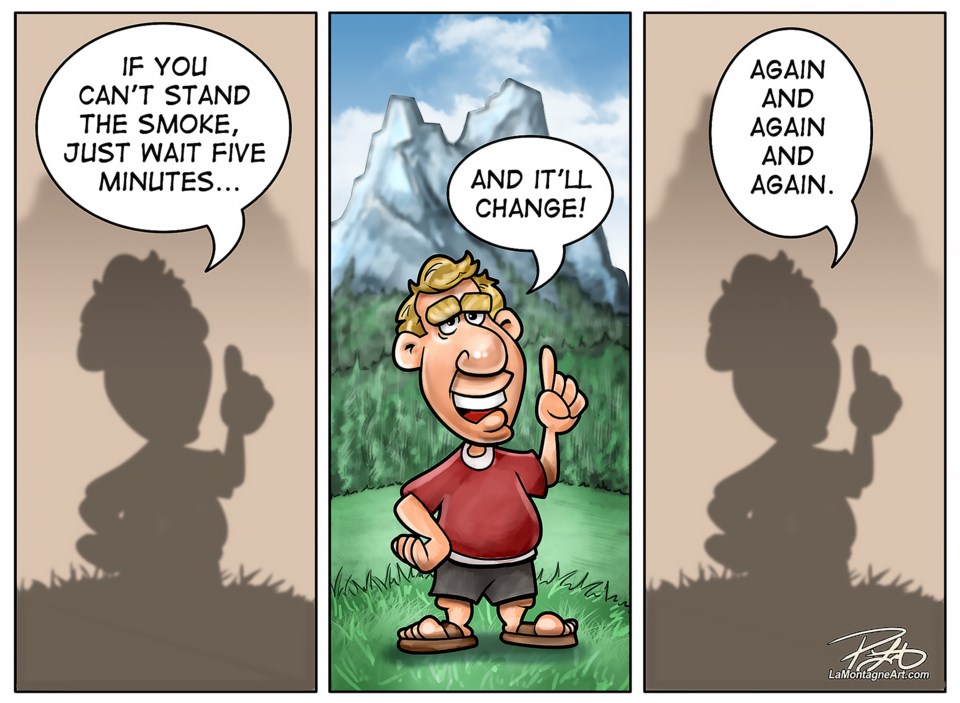The province is in the midst of its annual wildfire season and the Bow Valley is no exception.
The orangish smoke-filled skies are a common sight in western Canada throughout the summer months, but this year has been the worst in recorded history with more than 10 million hectares of forest burned in Canada.
The shocking number is more than six times the 10-year average of 1.4 million hectares being burned through the end of July, and with at least another two months of wildfire season, the number will only grow higher.
According to July 24 data from the Canadian Interagency Forest Fire Centre (CIFFC), there have been 3,875 wildfires this year that have burned more than 10 million hectares of forest. The previous record was 7.6 million hectares burned in 1989.
A July 24 report from Reuters said have 24,600 square kilometres will burn in an average wildfire season. This year, more than 100,000 square kilometres has gone up in flames and the season is only halfway through. To put it in perspective, the City of Toronto is 630 square kilometres.
Of course, hundreds of those wildfires – the ones caused by people – are entirely preventable with more responsible actions by the small minority of people who chose to ignore sound advice in stopping wildfires before they begin.
Areas that are normally immune to smoke such as in southern Ontario and the northeastern United States have been hammered by smoke due to wildfires in northern Quebec and northern Ontario.
With thousands of firefighters deployed across the country, nations such as South Africa, the United States, South Korea and Australia have sent hundreds more to aid in efforts to curtail them.
As of July 24, the Calgary Forest Area – which covers an area just outside the national parks – has responded to 40 wildfires that have burned just under five hectares and none are active.
In Canada, the wildfire season is starting earlier and lasts far longer than in the past.
The climate crisis has a direct correlation to the catastrophic season as above-normal temperatures and drought conditions lead to perfect conditions for forests to burn.
Kootenay National Park, a hotspot for wildfires, has seen close to 25 per cent of the park burned in the past two decades. That accounts for just under 34,000 hectares in an area well known for its lightning strikes.
As part of the forest ecology, areas of forest are meant to burn every couple hundred years to recharge the soil and landscape.
Prescribed burns play a key role in such a tactic, with more than a dozen scheduled each year. According to CIFFC data, there have been 12 such burns in 2023 totalling 1,180 hectares burned. But with the alarming wildfire spread this season, many have been called off with firefighting crews needed elsewhere across the country.
The short- and long-term health impacts of wildfire smoke have long been known. Health Canada estimates from 2013-18, there were up to 240 premature deaths each year to short-term exposure and up to 2,500 premature deaths to long-term impacts.
The economic impact was estimated by Health Canada to be between $410 million to $1.8 billion for acute health impacts and $4.3 billion to $19 billion for chronic health impacts.
And while information on the impacts of wildfire is well noted, and extreme danger alerts have started or been in place in many areas of the province, Alberta still lacks a much-needed fire ban.
In the region, the Bow Valley Clean Air Society has been an advocate for research and educating residents to help improve air quality. The Calgary Regional Airshed Zone also runs educational workshops and promotes methods to help air quality.
The reality is, the region will continue to be a hub for smoky days. Whether it’s fire from other areas of Alberta or British Columbia or the U.S, wildfire smoke is likely to only get worse in the coming years.




